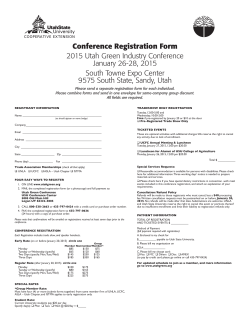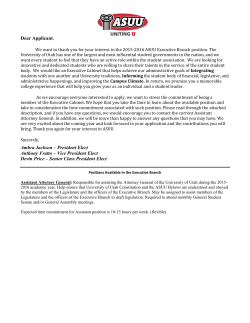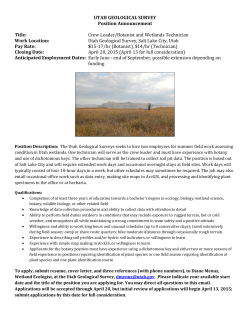
PDF - Energy & Geoscience Institute
In Progress Principal Investigator: Michal Nemčok, Ph.D. Research Professor Email: mnemcok@egi.utah.edu Rifts & Passive Margins Structural Architecture, Thermal Regimes & Petroleum Systems Author: Michal Nemčok Requesting Book Sponsorship There are more than 10 hydrocarbon fields discovered on oceanic crust in the Gulf of Mexico and Gulf of Guinea. Current academic research indicates that there are several types of oceanic crust and each of them has very different thermodynamic history. Investment per Sponsor Three-tier sponsorship $25k / $15k / 10k (USD) Duration 12 months Completion Q3 to Q4 2014 Nancy Taylor, Contracts & Assistant Business Manager EMAIL: ntaylor@egi.utah.edu PHONE: (801) 585-9137 We are requesting sponsorship from our CA members to prepare and deliver a systematic manual on exploration in rift and passive margin regions and improve the understanding of petroleum systems in these settings. The anticipated results are highly relevant to future successful exploration, to development of the new generation of exploration geologists, and to internal oil company training programs. The strategy is to merge results of the current literature and our internal research, and create a 500-page book called “Rifts and Passive Margins— Structural Architecture, Thermal Regimes and Petroleum Systems.” We consider this book to be somewhat of a second volume of the series that started with our successful book “Thrustbelts: structural architecture, thermal regimes and petroleum systems,” from Cambridge University Press. Our goal is to provide current and future explorers a comprehensive manual on exploration in rift and passive margins settings. Delivery is expected by mid– to late 2013. egi.utah.edu | EGI ... the science to find energy | EGIDirector@egi.utah.edu May 22, 2015 11:19 AM In Progress | Rifts & Passive Margins | Author: Michal Nemčok We have designed a three-tier sponsorship program that includes your corporate logo, short course, full manuscript review, discount books and a guest lecture by Dr. Michal Nemčok. Please be so kind to review Dr. Nemčok and Dr. Fraser’s CVs, and the levels of sponsorship available. Should you have any questions, contact Michal Nemčok or Raymond Levey for more information, clarification, and details specific to your level of interest. When you are ready to submit your sponsorship chose the level of sponsorship (on page 2). At that time we will send a license agreement for permission to use your corporate logo. Please return the signed license agreement authorizing use of your corporate logo and the specific corporate logo you prefer to have included in the book. Sponsorship Levels Platinum Level Sponsorship+ Corporate logo Name: ______________________________ PowerPoint slide short course Title: ______________________________ Full manuscript in PDF form* Guest Lecture by Dr. Michal Nemčok@ Sponsor acknowledgement page Signature: ____________________________ Sponsorship investment $25k (USD) Gold Level Sponsorship+ Corporate logo Full manuscript in PDF form* Sponsor acknowledgement page Sponsorship investment $15k (USD) Name: ______________________________ Title: ______________________________ Signature: ____________________________ Silver Level Sponsorship+ Corporate logo Sponsor acknowledgement page Sponsorship investment $10k (USD) Name: ______________________________ Title: ______________________________ Signature: ____________________________ EGI Technical Contacts Michal Nemčok, Research Professor Energy & Geoscience Institute at the University of Utah 423 Wakara Way, Suite 300, Salt Lake City Utah 84108 Tel. 421 254 630 337 (Bratislava, Slovakia) | Email: mnemcok@egi.utah.edu 2 In Progress | Rifts & Passive Margins | Author: Michal Nemčok EGI Sponsorship Contacts Nancy Taylor, Assistant Business Manager & Contracts Tel. (801) 585-9137 | Fax (801) 585-3540 | Email: ntaylor@egi.utah.edu Raymond Levey, Ph.D., EGI Director and Research Professor Energy & Geoscience Institute at the University of Utah Phone: 801-585-3826 | Email: rlevey@egi.utah.edu ____________________________ + Each sponsor will be required to return a fully executed license agreement. Sponsors agree that they will not be entitled to alter the content of the book or share in any part of the proceeds of book sales. Sponsors may purchase books at the following discounts: 100 copies at 30% off; 200 copies at 40% off; 300 copies at 50% off. * Full manuscript in PDF form is only for review purposes and should not be posted on any website or distributed widely. Sponsors may look at the PDF and then are asked to discard it immediately. @ Guest Lectures will be scheduled after the book is complete. Appendix A: Strategy & Deliverables We will integrate the results from current literature and our own research to create a 500-page book titled “Rifts and Passive Margins—Structural Architecture, Thermal Regimes & Petroleum Systems.” This work will be a comprehensive manual on exploration in rift and passive margins settings. The text will be supported by numerous seismic and geologic cross-sections, maps, and will be organized in three primary blocks. The first block will focus on development of the knowledge of the structural architecture in rift and passive margin terrains, together with an understanding of the controlling factors and their significance. The second block will discuss the knowledge of the thermal regimes and their controls. The first two blocks will progressively develop a foundation for the third block, that will focus on and describe petroleum systems in rift and passive margin terrains and their controlling factors. Additionally, each chapter will be converted into a PowerPoint slide show. The entire collection of slide shows will represent a comprehensive short course that can be used as internal training tool for sponsoring companies interested in the exploration of rift and passive margin settings for new venture and exploration teams. 3 In Progress | Rifts & Passive Margins | Author: Michal Nemčok Block 1. Structural architecture, basin development & fluid flow in rifts & passive margins Chapters 1. Basic description of structural styles in passive margin settings, including extension directions, key structural elements, and hydrocarbon occurrences 2. Mechanics of rifting and transition to drift phases 1. Determination of unstretched continental, thinned continental, proto-oceanic, and oceanic crustal boundaries in the study areas (i.e., South, Central, North and Equatorial Atlantic, Indian Ocean, East Africa, Southern California and Mexico) 2. Determination of timing of rift and/or transform events, thermal subsidence, and continental 3. 4. 5. 6. breakup Role of crustal composition and compositional variations on evolving rift margin architectural development and on breakup locations Role of pre-extensional tectonics and anisotropy on evolving rift structural styles and the effects of syn-extensional tectonics/anisotropy on passive margin structural style Role of syn-extensional deposition and erosion on evolving structural styles of passive margins and effects of tectonics on deposition and erosional patterns Fluid flow models along oceanic fracture zones (transforms), hot spot or hot line-associated volcanic chains and continental transfer fault systems Block 2. Thermal regime in rifts and passive margins Chapters 1. Role of pre-rift heat flow on syn-rift thermal regimes and effects of syn-rift heat flow on thermal regimes of passive margins 2. Influence of structural and stratigraphic architecture on thermal regimes 3. Role of syn-rift deposition and erosion on thermal regimes of rifts and the effects of post-rift deposition and erosion on thermal regimes 4. Effects of deformation on thermal regimes 5. Roles of fluid movement on thermal regimes Block 3. Petroleum systems in rifts and passive margins Chapters 1. 2. 3. 4. 5. 6. Models of source rock distribution, maturation and expulsion Models of reservoir quality distribution Sealing characteristics Models of hydrocarbon migration Trapping styles Hydrocarbon preservation 4 In Progress | Rifts & Passive Margins | Author: Michal Nemčok Appendix B: Curricula vitae Michal Nemčok Professional address: Research Professor Energy & Geoscience Institute at the University of Utah 423 Wakara Way, Suite 300, Salt Lake City, Utah 84108, USA Phone: 1-801-585 9829 Fax: 1-801-585 3540 and Energy & Geoscience Institute Laboratory at Geological Institute of Slovak Academy of Sciences Dúbravská cesta 9 SK-840 05 Bratislava Slovak Republic Phone: 421-2-5463-0337 E-mail: mnemcok@egi.utah.edu www.egi.utah.edu and http://egi.utah.edu/about/staff/michal-nemcok.php Born 1961 – July 2, Bratislava, Slovak Republic Education 2009 – Doctor of Geologic Sciences, Slovak Academy of Sciences, Bratislava, Slovakia (February 4, 2009). Thesis title: “Thrustbelts; structural architecture, thermal regimes and petroleum systems”. 2002 – Venia docendi in Geology, University of Freiberg, Freiberg, Germany (May 21, 2002). Thesis title: “Paleostress methods and development of the Carpathian orogenic belt” (in German). 1991 – Ph.D. dissertation, Comenius University, Bratislava, Czechoslovakia Title: The Cenozoic Development of Western Half of the West Carpathian Orogenic Belt (in Slovak). Graduate and undergraduate work, Comenius University Bratislava, Czechoslovakia: structural geology, sedimentology, paleontology, ore analysis, geochemistry, petrology, mineralogy, programming, stratigraphy, economic geology, tectonics. Academic experience & other employment * Research Professor at Energy and Geoscience Institute at University of Utah (January 2000 – present) * Adjunct Professor at Department of Geology and Geophysics at University of Utah while keeping the Research Professorship at EGI (July 2007 – July 2011) 5 In Progress | Rifts & Passive Margins | Author: Michal Nemčok * Research Assistant Professor at Energy and Geoscience Institute at University of Utah (August 1998 – January 2000) * Alexander von Humboldt fellow at University of Würzburg, Germany (March 1997 - August 1998) * Head of Hydrocarbon Exploration Department at Slovak Geological Survey (October 1996 – August 1998), * Lise Meitner fellow at University of Salzburg, Austria (October 1995 - October 1996) * Teaching visiting professor, European Summer School for graduate students of Earth Sciences (June 1995) * Postdoctoral fellow at Imperial College of Sciences, London, UK (April 1994 - August 1995) * Royal Society fellow at University of Wales, Cardiff, UK (February 1993 - February 1994) * Teaching visiting professor at Comenius University, Bratislava, Czechoslovakia (12 months in 1992) * Visiting scientist at Department of Geology, Imperial College of Sciences, London, UK (December, 1991) * Researcher at Structural Department, Slovak Geological Survey, Bratislava, Slovakia (May 1991 – October 1996) * Research associate at ESRI, University of South Carolina, Columbia, SC, USA (July 1990 - May 1991) * Research assistant at Dionyz Stur Geologic Institute, Bratislava, Czechoslovakia (October 1985 – July 1990) Research interests * factors controlling continental break-up * mechanisms of continental break-up * stress and fracture prediction Publications Choudhuri, M., Nemčok, M., Stuart, C., Welker, C., Sinha, S. T., Bird, D. and Sinha, N., 2013. 85o E Ridge, India – constraints on its development and architecture. Journal of the Geological Society of India, JGSI-D-12-00285, in press. Nemčok, M., Stuart, C. J., Rosendahl, B. R., Welker, C., Smith, S., Sheya, C., Sinha, S. T., Choudhuri, M., Allen, R., Reeves, C., Sharma, S. P., Venkatraman S. & Sinha, N., 2012. Continental break-up mechanism; lessons from intermediate- and fast-extension settings. In: Mohriak, W. U., Danforth, A., Post, P. J., Brown, D. E., Tari, G. M., Nemčok, M. and Sinha, S. T. (Eds), Conjugate Divergent Margins. Geological Society of London Special Publication, 369. doi: 10.1144/SP369.14 6 In Progress | Rifts & Passive Margins | Author: Michal Nemčok Nemčok, M., Henk, A., Allen, R., Sikora, P. J. and Stuart, C., 2012. Continental break-up along strike-slip fault zones; observations from Equatorial Atlantic. In: Mohriak, W. U., Danforth, A., Post, P. J., Brown, D. E., Tari, G. M., Nemčok, M. and Sinha, S. T. (Eds), Conjugate Divergent Margins. Geological Society of London Special Publication, 369. doi: 10.1144/SP369.8. Nemčok, M., Sinha, S. T., Stuart, C., Welker, C., Choudhuri, M., Sharma, S. P., Misra, A. A., Sinha, N. and Venkatraman, S., 2012. East Indian margin evolution and crustal architecture: integration of deep reflection seismic interpretation and gravity modeling. In: Mohriak, W. U., Danforth, A., Post, P. J., Brown, D. E., Tari, G. M., Nemčok, M. and Sinha, S. T. (Eds), Conjugate Divergent Margins. Geological Society of London Special Publication, 369. doi: 10.1144/SP369.6. Stuart, C. J., Nemčok, M., Vangelov, D., Higgins, E. R., Welker, C. and Meaux, D., 2011. Structural and depositional evolution of the Eastern Balkan thrustbelt, Bulgaria. AAPG Bulletin, 95(4), 649-673. Pospíšil, L. and Nemčok, M., 2010. Geophysical model of the Carpathian-Pannonian lithosphere. Geological and geophysical data analyses. Lambert Academic Publishing, Saarbrucken, 1-205 pp. Sheya, C. R. and Nemčok, M., 2010. Computerized play fairway map construction: A communication tool between geologists and economists in geological exploration (in Slovak). SLOVGAS, 24(1), 33-36. Tari, G. and Nemčok, M., 2009. Introduction to this special section: The Black Sea Region. In: Tari, G. and Nemčok, M. (Eds.), The Black Sea Region. The Leading Edge, September, 1022-1023. Meisner, A., Krylov, O. and Nemčok, M., 2009. Development and structural architecture of the Eastern Black Sea. In: Tari, G. and Nemčok, M. (Eds.), The Black Sea Region. The Leading Edge, September, 1046-1055. Henk, A. and Nemčok, M., 2008. Stress and fracture prediction in inverted half-graben structures. Journal of Structural Geology, 30(1), 81-97. Mohriak, W. U., Nemčok, M. and Enciso, G., 2008. South Atlantic divergent margin evolution: rift-border uplift and salt tectonics in the basins of SE Brazil. In: Pankhurst, R. J., Trouw, R. A. J., de Brito Neves, B. B. and De Witt, M. J. (Eds.), West Gondwana: Pre-Cenozoic correlations across the South Atlantic region. Geological Society, London, Special Publications, 294, pp. 365-398. Moore, J. N., Allis, R. G., Nemčok, M., Powell, T. S., Bruton, C., Wannamaker, P. E., Raharjo, I. B. and Norman, D. I., 2008. The evolution of volcano-hosted geothermal system based on deep wells from Karaha-Telaga Bodas, Indonesia. American Journal of Science, 308(1), 1-48. Nemčok, M., Dilov, T., Wojtaszek, M., Ludhová, L., Klecker, R. A., Sercombe, W. J., Coward, M. P., 2007. Dynamics of the Polish and Eastern Slovakian parts of the Carpathian accretionary wedge: insights from paleostress analyses. In; Ries, A. C., Butler, R. W. H. and Graham, R. H. (Eds.), Deformation of the continental crust: The legacy of Mike Coward, Geological Society, London, Special Publications, 272, 271-302. Nemčok, M., Moore, J. N., Christensen, C., Allis, R., Powell, T., Murray, B. and Nash, G., 2006. Controls on the Karaha-Telaga Bodas geothermal reservoir, Indonesia. Geothermics, 36, 9-46. Clausen, S., Nemčok, M., Moore, J., Hulen, J. and Bartley, J., 2006. Mapping fractures in the Medicine Lake geothermal system. Geothermal Resources Council Transactions, 30, 383-386. 7 In Progress | Rifts & Passive Margins | Author: Michal Nemčok Nemčok, M., Krzywiec, P., Wojtaszek, M., Ludhová, L., Klecker, R. A., Sercombe, W. J., Coward, M. P., 2006. Tertiary development of the Polish and Eastern Slovakian parts of the Carpathian accretionary wedge: insights from balanced cross sections. Geologica Carpathica, 57(5), 355-370. Pospíšil L., Ádám, A., Bimka, J., Bodlak, P., Bodoky, T., Dövényi, P., Granser, H., Hegedüs, E., Joó, I., Kendzera, A., Lenkey, L., Nemčok, M., Posgay, K., Pylypyshyn, B., Sedlák, J., Stanley, W. D., Starodub, G., Szalaiová, V., Šály, B., Šutora, A., Várga G. and Zsíros, T., 2006. Regional geophysical data on the Carpathian-Pannonian lithosphere. In: Pícha, F. and Golonka, J. (Eds.), The Carpathians and their foreland: geology and hydrocarbon resources, AAPG Memoir, 84, pp. 651-697. Nemčok, M., Pospíšil, L., Hrušecký, I. and Zsíros, T., 2006. Subduction in the remnant Carpathian Flysch Basin. In: Pícha, F. and Golonka, J. (Eds.), The Carpathians and their foreland: geology and hydrocarbon resources, AAPG Memoir, 84, pp. 767-785. Nemčok, M., Pogacsás, G and Pospíšil, L., 2006. Activity timing of the main tectonic systems in the Carpathian-Pannonian region in relation to the roll-back destruction of the lithosphere. In: Pícha, F. and Golonka, J. (Eds.), The Carpathians and their foreland: geology and hydrocarbon resources, AAPG Memoir, 84, pp. 743-766. Nemčok, M. and Henk, A., 2006. Oil reservoirs in foreland basins charged by thrustbelt source rocks: insights from numerical stress modelling and geometric balancing in the West Carpathians. In: Buiter, S.J.H. and Schreus, G. (Eds.), Analogue and numerical modelling of crustal-scale processes. Geol. Soc., London, Spec. Publ., 253, 415-428. Nemčok, M., Stuart, C., Segall, M.P., Allen, R.B., Christensen, C., Hermeston, S. A., Davison, I., 2005. Structural development of South Morocco: interaction of tectonics and deposition. In: Post, P.J., Rosen, N., Olson, D.L., Palmes, S.L., Lyons, K.T. and Newton, G.B. (Eds.), Petroleum systems of divergent continental margin basins, 25th Annual GCSSEPM Foundation Bob F. Perkins Research Conference, Session I, Crustal architecture of divergent margins, GCSSEPM, Houston, ISSN: 15442462, pp. 151-202. Nemčok, M., Schamel, S and Gayer, R. A., 2005. Thrustbelts: structural architecture, thermal regimes and petroleum systems. Cambridge University Press, Cambridge, 1-541pp. Nemčok, M., Moore, J. N., Christensen, C., Allis, R., Powell, T., Murray, B. and Nash, G., 2005. Reservoir controlling factors in the Karaha-Telaga Bodas geothermal field, Indonesia. Geothermal Resources Council Transactions, 29, 407-412. 8 Research Professor Michal Nemčok, Ph.D. Michal holds a Ph.D. in Structural Geology from the Comenius University, Bratislava. He has 28 years of applied and basic research experience at the Slovak Geological Survey, University of South Carolina, University of Wales, Cardiff, Imperial College London, University of Salzburg, University of Wurzburg, and University of Utah. He joined EGI in 1998 and is a Research Professor and Structural Group leader. Michal has published 70+ articles, coauthored 3 monographs, and coedited four books. Continental Break-up Processes & Controlling Factors Email mnemcok@egi.utah.edu Phone 421-2-5463-0037 (SK) Research Interests • Continental break-up processes and controlling factors • Thrustbelt development and controlling factors • Fracture development prediction Continental break-up research focuses on both extensional and transform settings, with a focus on driving mechanisms and controlling factors to achieve predictive models with respect to structural architecture, thermal regimes, and petroleum systems. The main research contribution includes understanding anomalous thermal and uplift histories of transform margins, break-up mechanisms at intermediate and fast extensional settings, and micro-continent-releasing mechanisms. A summary of his last eight years of breakup research is recorded in a monograph titled “Rifts and Passive Margins; Structural Architecture, Thermal Regimes and Petroleum Systems”, currently in press at Cambridge University Press, and authored by Nemčok, M. Thrustbelt Development & Controlling Factors Michal’s current research focuses on the thrustbelt-foreland interactions, with a concentration on driving mechanisms and controlling factors behind thick-skin tectonics, foreland plate flexure mechanisms, and flexural faulting in control of structural architecture and play concept elements. The main research contribution includes the factors and mechanisms leading to the lack of foreland flexing and transitions from initial inversion to full accretion. Accompanying research focuses on modeling of the fluid flow mechanisms occurring in the thrustbelt front and its foreland. A summary of thrustbelt research is written in a monograph called “Thrustbelts; Structural Architecture, Thermal Regimes and Petroleum Systems”, published by Cambridge University Press, and authored by Nemčok, M., Schamel, S. and Gayer, R.. Current research findings are summarized in several articles included in the Geological Society of London Special Publication 377, which is edited by Nemčok, M., Mora, A., and Cosgrove, J. Fracture Development Prediction Fracture prediction research includes both detailed well core, rock outcrop and numerical simulation studies focused on predicting timing, location and kinematics of developing fractures. Most of the fracture studies come from thrustbelts, although some core-based studies come from various geothermal reservoirs. The main research contribution includes tools capable of predicting fracture locations, kinematics and propagation timing in two and three-dimensions for hydrocarbon reservoirs in thrustbelts, which were tested by well-based fracture data. Accompanying research includes understanding the role of mechanical stratigraphy on developing structural architecture. This research is published in a number of journals run by structural and geothermal communities. egi.utah.edu | EGI ... the science to find energy | EGIDirector@egi.utah.edu September11,201412:20PM
© Copyright 2025









